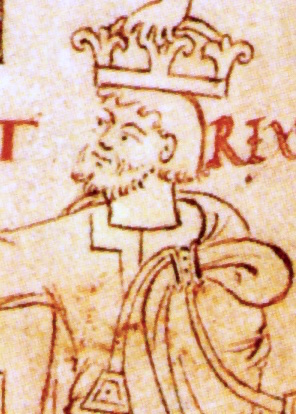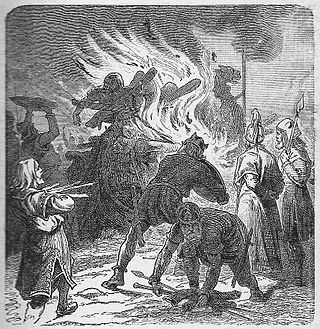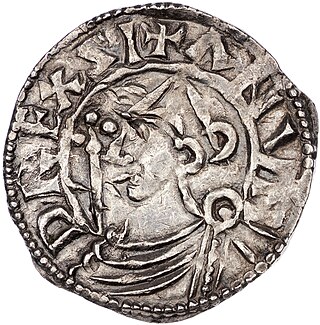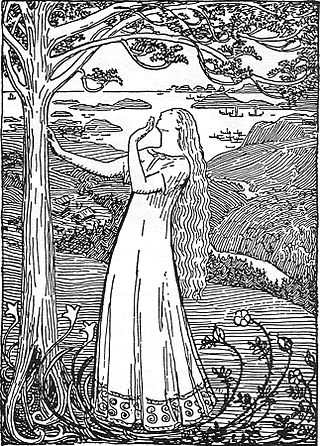Gesta Hammaburgensis ecclesiae pontificum of Adam of Bremen
Two possible references to Harthacnut appear in the work of clergyman Adam of Bremen, who came from Germany to record the history of the Archbishops of Bremen (Gesta Hammaburgensis ecclesiae pontificum), partly based on information from Gorm's descendant, Sweyn II of Denmark. Adam states that a king Helge was deposed and Denmark was conquered by Olof the Brash who came from Sweden (Sueonia). Along with two of his sons, Gyrd and Gnupa, Olof took the realm "by force of arms," [1] and they ruled it together, thus founding the House of Olaf in Denmark. Adam reports that they were followed by a Sigtrygg. That Sigtrygg was the son of Gnupa by a Danish noblewoman named Asfrid, and is shown on two runestones near Schleswig, erected by his mother after his death. [2]
Adam then relates that after Sigtrygg reigned a short time, during the tenure of Archbishop Hoger of Bremen (909–915/917), Hardegon, son of Sweyn, came from "Northmannia" the "land of the Northmen," by which he may have meant Norway, Northumbria, Normandy, which had recently been colonized by Danish Vikings, or even northern Jutland. Hardegon immediately deposed the young king Sigtrygg, and then ruled unopposed for approximately thirty years. Hardegon is often equated with the Harthacnut of legend, but some historians, such as Lis Jacobsen, instead have concluded that Hardegon is distinct. [3]
Adam later refers to an attack on Denmark by Henry I of Germany, naming the defending king as Hardecnudth Vurm in some manuscripts, filius Hardecnudth Vurm in others. Historians generally agree that Vurm (English: worm or serpent) is a German rendering of the Danish name Gorm, and this leads to alternative interpretations, that this is reference to Gorm, son (filius) of Harthacnut, or that it is a double-name indicating that Harthacnut and Gorm were the same person. The Saxon chronicles of Widukind of Corvey report the defeat and forced baptism of the Danish king Chnuba (Gnupa), in 934 at the hands of Henry I. [4] Likewise, Olav Tryggvasson's Saga tells of Gnupa's defeat by Gorm the Old. [5] Some historians (e.g. Storm) have taken these as indications that Sigtrygg's father Gnupa still ruled at least part of Denmark much later than credited by Adam of Bremen, and his dynasty was only displaced by Harthacnut's son, Gorm.

Cnut, also known as Canute and with the epithet the Great, was King of England from 1016, King of Denmark from 1018, and King of Norway from 1028 until his death in 1035. The three kingdoms united under Cnut's rule are referred to together as the North Sea Empire by historians.

Harald "Bluetooth" Gormsson was a king of Denmark and Norway.

Ragnar Lodbrok, according to legends, was a Viking hero and a Swedish and Danish king.

Magnus Olafsson, better known as Magnus the Good, was King of Norway from 1035 and King of Denmark from 1042 until his death in 1047.

Gorm the Old, also called Gorm the Languid, was ruler of Denmark, reigning from c. 936 to his death c. 958 or a few years later. He ruled from Jelling, and made the oldest of the Jelling stones in honour of his wife Thyra. Gorm was born before 900 and died perhaps around 958 or possibly 963 or 964.

Sigurd Ring according to legend was a king of the Swedes, being mentioned in many old Scandinavian sagas. According to these sources he was granted rulership over Sweden as a vassal king under his uncle Harald Wartooth. Later he would take up arms against his uncle Harald in a bid to overthrow him and take the crown of Denmark, a conflict which Sigurd eventually won after the legendary Battle of the Brávellir, where it is said that Odin himself intervened and killed Harald. In the Sagas, Sigurd is also known for being the father of the Norse Viking hero and legendary king of Denmark and Sweden, Ragnar Lodbrok. According to Bósa saga ok Herrauds, there was once a saga on Sigurd Ring, but this saga is now lost.

Björn Ironside, according to Norse legends, was a Norse Viking chief and Swedish king. According to the 12th- and 13th-century Scandinavian histories, he was the son of notorious Viking king Ragnar Lodbrok and lived in the 9th century AD, attested in 855 and 858. Björn Ironside is said to have been the first ruler of the Swedish Munsö dynasty. In the early 18th century, a barrow on the island of Munsö was claimed by antiquarians to be Björn Järnsidas hög or Björn Ironside's barrow.

Anund Jacob or James was King of Sweden from 1022 until around 1050. He is believed to have been born on 25 July, in either 1008 or 1010 as Jakob, the son of King Olof Skötkonung and Queen Estrid. Being the second Christian king of the Swedish realm, his long and partly turbulent reign saw the increasing dissemination of Christianity as well as repeated attempts to influence the balance of power in Scandinavia. Throughout his reign, he tried to subvert the rising Danish hegemony in Scandinavia by supporting the Norwegian monarchy. He also supported the reign of his brother-in-law Yaroslav the Wise in Kievan Rus. He is referred to in positive terms in German and Norse historical sources. His reign was one of the longest in Sweden during the Viking Age and Middle Ages.

Sigurd Snake-in-the-eye or Sigurd Ragnarsson was a semi-legendary Viking warrior and Danish king active from the mid to late 9th century. According to multiple saga sources and Scandinavian histories from the 12th century and later, he is one of the sons of the legendary Viking Ragnar Lodbrok and Áslaug. His historical prototype might have been the Danish King Sigfred who ruled briefly in the 870s. Norwegian kings' genealogies of the Middle Ages name him as an ancestor of Harald Fairhair and used his mother's supposed ancestry to Völsung in order to create an ancestry between Harald and his descendants and Odin.

Sigtrygg Gnupasson was semi-legendary a king of Denmark of the House of Olaf who ruled in the 10th century, according to Adam of Bremen.
Gyrd and Gnupa were kings of Denmark in the 10th century according to Sweyn II of Denmark and Adam of Bremen. They were the sons of the Swedish chieftain Olof the Brash who had conquered Denmark and they ruled together according to Swedish tradition.

Ulf Thorgilsson, commonly known as Ulf Jarl or Earl Ulf, was a Danish jarl of Skåne and regent of Denmark. Ulf was the son of Thorgil Sprakling and the father of King Sweyn II of Denmark and thus the progenitor of the House of Estridsen, which would rule Denmark from 1047 to 1375, which was also sometimes, specially in Swedish sources, referred to as the Ulfinger dynasty to honor him.
The two Sigtrygg Runestones, designated as DR 2 and DR 4 in the Rundata catalog, are two of the Hedeby stones that were found in Schleswig-Holstein, Germany, which during the Viking Age was part of Denmark. The runestones were raised after the Danish king Sigtrygg Gnupasson by his mother Ásfriðr. Together with the account of Adam of Bremen, the two inscriptions constitute evidence for the House of Olaf on the Danish throne.

The Tale of Ragnar's sons is an Old Norse story about Ragnar Lodbrok and his sons.
Sigurd Hart or Sigurd Hjort was a legendary king of Ringerike, during the late 9th or early 10th centuries. he is mentioned in Ragnarssona þáttr and in Halvdan Svartes saga.

The name Ragnhild Sigurdsdotter may refer to two different figures from Old Norse literature, an amalgam of them, or a purely fictitious figure.

The Danish House of Knýtlinga was a ruling royal house in Middle Age Scandinavia and England. Its most famous king was Cnut the Great, who gave his name to this dynasty. Other notable members were Cnut's father Sweyn Forkbeard, grandfather Harald Bluetooth, and sons Harthacnut, Harold Harefoot, and Svein Knutsson. It has also been called the House of Canute, the House of Denmark, the House of Gorm, or the Jelling dynasty.
The Tale of Ragnarr Loðbrók is an Icelandic legendary saga of the 13th century about the Viking ruler Ragnarr loðbrók. It is first found in the same manuscript as Vǫlsunga saga, which it immediately follows. The tale covers the origin of Áslaug, Ragnarr's quest for the hand of Þóra borgarhjǫrtr, his later marriage to Áslaug, the deeds of their sons in battle, and Ragnarr's death at the hands of king Ælla of Northumbria.















